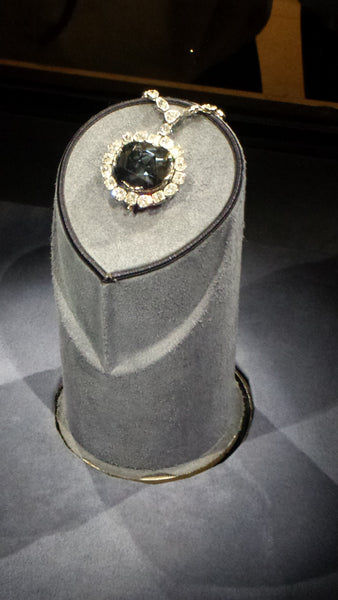The Hope Diamond April 27 2017
This weekend, I had the privilege of visiting the Smithsonian Museum of Natural History. Entering the dome shaped building near the National Mall was an exhilarating experience as I was excited to see an assortment of wonders from the ancient mummies of Egypt to the weird and wonderful creatures of our planet. However, there was one exhibition that was at the forefront of my mind: The Hope Diamond. I tried my best to enjoy the path leading up to the second floor which housed this glamorous piece, but my impatience and overflowing excitement got the better of me. So, I rushed past all the exhibits and reached the gemological museum to witness the sparkle and glimmer of a diamond with a 300-year-old history from the market, to monarchs and a museum.
The Hope Diamond originated in India, one of the only sources of diamonds in the early 16th century. In 1668 a French merchant by the name of Jean Baptiste Tavernier, acquired this natural gemstone at a weight of approximately 112 carats and sold it to King Louis XIV of France. Early drawings of this magnificent stone depicted that it was cut in an Indian style which emphasized weight over brilliance. In order to achieve the desired aesthetics, King Louis XIV recut the diamond as an addition to the French Crown Jewels, which by 1749 was called the Emblem of the Golden Fleece. To my disappointment, I had learned that by this process, the weight of the diamond has been reduced by over half its original size to a mere 67 carats!
 The Hope Diamond reached the shores of America when Evalyn Walsh Mclean bought it from the collections of Pierre Cartier of Paris who is credited with its current shape and design. It has been rumored that Mike, Mrs. Walsh’s great dane, had once modeled the Hope Diamond and was rather playful in hiding the $250 million pendant in the crooks of their living room sofa. Upon the death of Mrs. Walsh, Harry Winston, a prominent jeweler in New York City, bought the Hope Diamond with the intention of giving it to the government as the start of a great jewel collection. As such, in 1958, he donated the Hope Diamond to the Smithsonian Institution and has been marveled by generations since then.
The Hope Diamond reached the shores of America when Evalyn Walsh Mclean bought it from the collections of Pierre Cartier of Paris who is credited with its current shape and design. It has been rumored that Mike, Mrs. Walsh’s great dane, had once modeled the Hope Diamond and was rather playful in hiding the $250 million pendant in the crooks of their living room sofa. Upon the death of Mrs. Walsh, Harry Winston, a prominent jeweler in New York City, bought the Hope Diamond with the intention of giving it to the government as the start of a great jewel collection. As such, in 1958, he donated the Hope Diamond to the Smithsonian Institution and has been marveled by generations since then.
By 1792, the diamond was stolen by a bandit of looters during the week-long French Revolution. Its whereabouts remained unknown for about 20 years until it resurfaced in London a day after the statute of limitations for the prosecution of this theft had expired. A memorandum in 1812 by John Francillion, a London based jeweler, explained that a blue diamond of 44.52 carat was sold to King George IV and was almost certainly the one stolen from the Crown Jewels in France. After the death of King George IV in 1830, the diamond was bought by a London banker by the name of Henry Philip Hope, and from then on, the diamond bore his name. It stayed within his family until 1901 but reached the hands of retailers from across the world as he passed away.
My visit to this museum was incredibly educational and fascinating! It is hard to put into words the magnificence of this piece but I hope that one day that you too will be fortunate to witness the awe-inspiring sparkle of this natural blue diamond.
